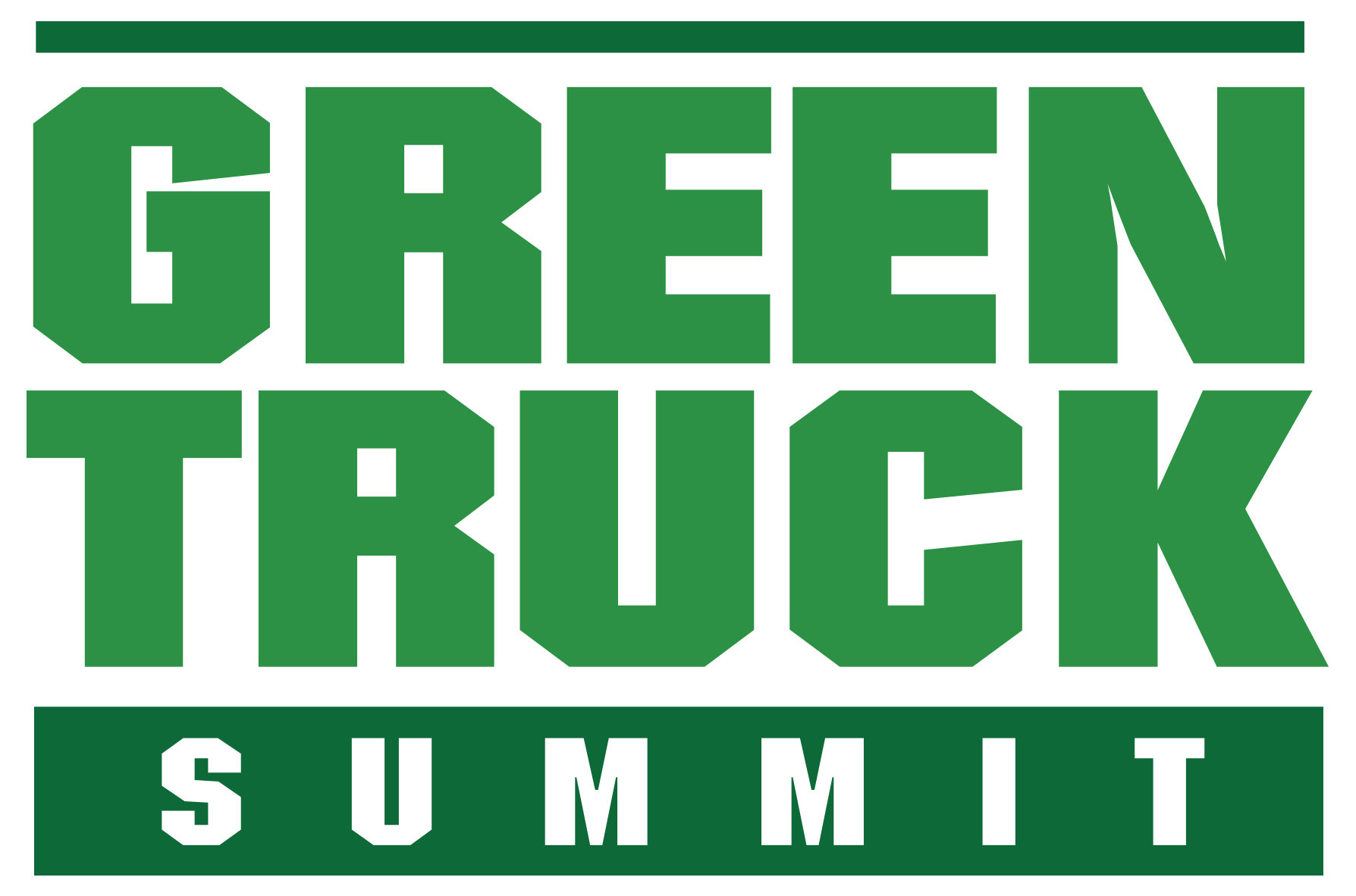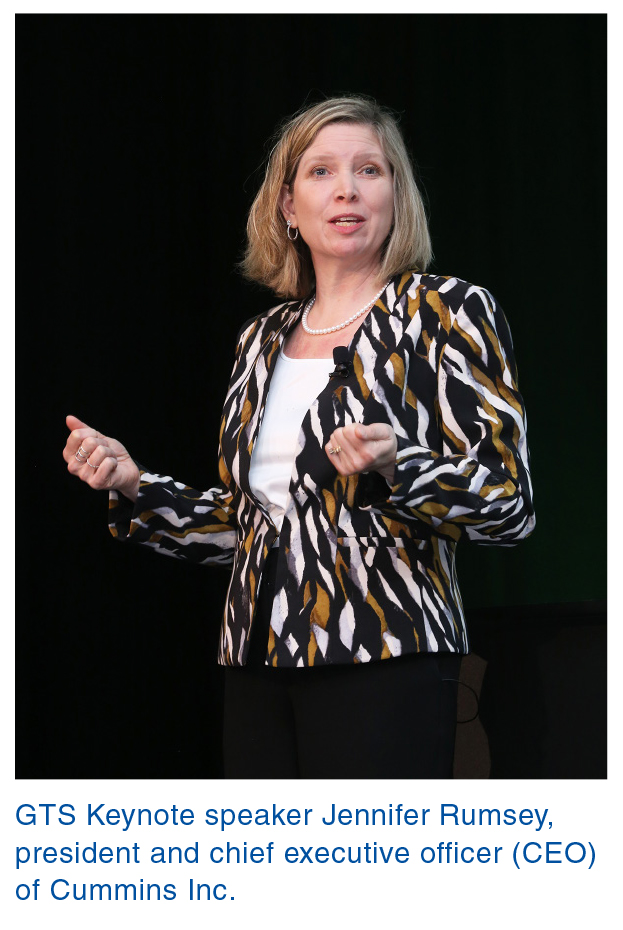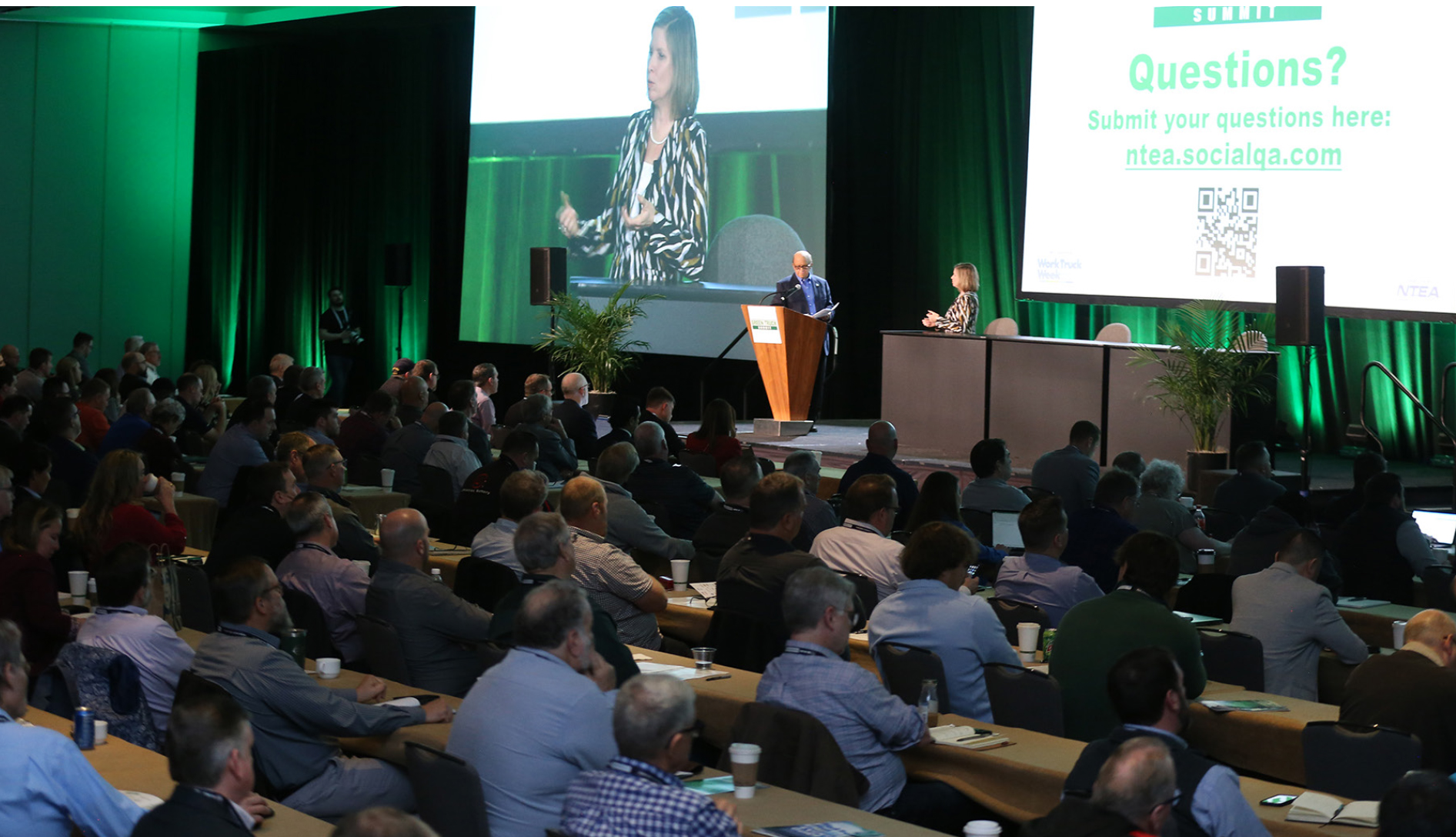
This article was published in the April 2023 edition of NTEA News.
Held in conjunction with Work Truck Week 2023, Green Truck Summit provided insights, solutions and resources in support of the work truck industry’s drive toward achieving greater sustainability, productivity and efficiency. This year’s sold out event offered intensive programs from industry experts, government representatives, fleets, and vehicle and equipment manufacturers. Sessions addressed the evolution of the commercial vehicle landscape as the shift toward zero emissions continues to accelerate.
John Davis, creator, host and executive producer of MotorWeek, returned as emcee. Sponsored by Freightliner, the event featured a keynote address, two general sessions and a slate of afternoon breakout sessions, followed by a closing session and reception.
 Keynote address
Keynote address
Jennifer Rumsey, president and chief executive officer (CEO) of Cummins Inc., delivered the Green Truck Summit keynote address. In her role, Rumsey oversees the strategic direction, growth initiatives and global operations for the 103-year old, Indiana-based company. She has focused her 25-year career on advancing technology and bringing products to market that power customers’ success and make a positive difference in the world. She co-authored Cummins’ Destination Zero, the company’s strategy to go further, faster to reduce the greenhouse gas (GHG) and air quality impacts of its products and reach net-zero emissions by 2050. Rumsey is passionate about building high-performing, diverse teams and has dedicated her time at Cummins to the development of others and creating a welcoming environment where innovation thrives.
During her keynote, Rumsey expanded on the Destination Zero strategy and how Cummins is investing in the right technologies at the right time with a deep understanding of customers as they work to decarbonize the industry in a way that’s optimal for all stakeholders.
“Our industry is in the heart of the economy serving some of the world’s most important applications we all count on day in and day out, and they contribute meaningfully to global C02 emissions. So how we decarbonize this industry in a way that makes sense for the environment, for our customers and for our world that it serves is important,” said Rumsey.
She shared how people — such as employees, customers and investors —have always been a focus for her. She thinks of the responsibility we have for future generations, and starting with customers, she considers their needs today, and how to help them decarbonize and move toward the path to zero emissions and innovation to meet their needs.
“At the end of the day, it’s about delivering results for our customers, the environment and also to our investors,” she added. “Cummins has grown over the last 20 years from a $6.6 billion revenue company to last year’s record $28 billion revenue company. We will continue to grow. We see decarbonization as a growth opportunity for Cummins as we deliver strong results to our investors as well.”
She shared how Cummins, a leader in technologies for zero tailpipe emissions in commercial and industrial applications, is investing to strengthen that position, as well as leading in transition technologies — which will be needed for many years — to lower carbon emissions while still offering customers economic solutions.
She emphasized Cummins believes a path with an evolving range of technologies is the right strategy to serve its diverse market of customers. One solution simply won’t work for all applications, given varying requirements, duty cycles, power needs, life expectations and the environment in which they operate.
The adoption rate of industry decarbonized solutions will be paced by multiple factors and will vary given these application and regional differences, such as significant infrastructure build out, including charging and refueling capabilities; economics and the cost of adoption; customer acceptance and infrastructure availability; and governmental regulations, policy and incentives.
Regarding the drive toward a zero carbon future, she said Cummins sees the technology transitioning in three phases over the coming decades:
- Phase one (current phase): Advancing a range of solutions, including making current technologies which will remain on the road for years, cleaner
- Phase two: Investing in innovation and advancing zero carbonization technologies; advancing adoption where it makes sense; and building on infrastructure. (During this middle phase Cummins refers to as the messy middle, many solutions will coexist depending on the application and the region of the world.)
- Phase three: Broad adoption of zero emission technologies with a decarbonized infrastructure in place to support the technologies where that ultimate goal of getting to zero is met.
“Standing here today, it may seem like we have plenty of time to get to 2050, but it is critical we start today to get toward zero and focus on how we advance these long-term solutions and the infrastructure that will get us to zero,” Rumsey concluded.

General sessions
Two general sessions in the morning covered advances in battery technology and insights on electric vehicle deployment, challenges and factors that will affect EV adoption.
In Powering the Future: Challenges and Opportunities in Vehicle Battery Technology, Giorgio Rizzoni, director at The Ohio State University Center for Automotive Research, shared how advancements in battery technology and materials will allow for continued growth in the vocational market.
Andrew Wrobel, director, auto & mobility at Escalent, led The Electric Vehicle Balancing Act session. While EV interest and consideration are strong, the ability to meet these objectives remains murky. Wrobel discussed what the commercial vehicle market is capable of deploying, what challenges we’ll face and what will affect real change in adoption based on a bottom-up approach to forecasting.
Breakout sessions
Following the Green Truck Summit morning sessions and lunch, attendees were able to choose from four sets of breakout sessions in the afternoon. Topics included:
- Advanced Alternatives: Future Emissions Landscape
- Electric Foundations: Grants & Programs
- Sponsored Update: Allison Transmission
- Advanced Alternatives: Idle Reduction
- Electric Foundations: Spec’ing the Chassis
- Sponsored Update: SEA Electric
- Advanced Alternatives: Hydrogen Fuel Cells and Infrastructure –Factors to Consider
- Electric Foundations: Charging Your Infrastructure
- Advanced Alternatives: Future of Engine
- Electric Foundations: Embarking on the Fleet Journey
- Sponsored Update: Hino Trucks
Closing session
New this year, all Green Truck Summit attendees gathered for Bringing it Home – Green Truck Association Closing Session. During this wrap-up, current and past leaders of NTEA’s Green Truck Association served as the “voice of reason,” highlighting key elements of the day’s sessions and discussing issues affecting the work truck industry. Moderated by Ed Hoffman, owner/founder at Hoffman Fleet, session panelists included Jim Castelaz, founder & CTO at Motiv; Paul Kokalis, president of Fontaine Modification; and Scott Phillippi, chief continuity officer at REE Automotive. Green Truck Summit concluded with a reception for attendees.
See a full recap of Work Truck Week, including photos, at worktruckweek.com/coverage.